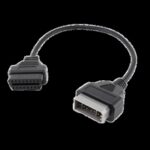Converting an older OBD1 Honda Civic to OBD2 for emissions testing or ECU compatibility can be a common need for car enthusiasts. This process, while not a straightforward “conversion” in the strictest sense, often involves making an OBD1 engine function with an OBD2 system for specific purposes like passing emissions. Let’s delve into how this is approached, focusing on practical advice and legal considerations.
One suggested method involves utilizing components from later OBD2 Civics to temporarily meet OBD2 requirements. For instance, to make a Z6 engine (an OBD1 engine) pass OBD2 emissions, some mechanics propose using a Y7 or Y8 ECU (OBD2 ECUs). This often necessitates employing a “CFK trick” or physically installing a Y7/8 oil pan and oil pump to accommodate the crank sensor required for OBD2 systems. The idea is to temporarily configure the engine to be compatible with OBD2 diagnostics for testing, and then revert back to an OBD1 ECU afterward if desired.
Alt text: Engine bay of a Honda Civic with focus on OBD system components, illustrating a potential OBD1 to OBD2 conversion scenario.
It’s crucial to acknowledge the legal implications of such modifications. Emissions regulations often stipulate that engine swaps or modifications must maintain or improve the emission standards of the original vehicle. According to the EPA, installing an engine into a different vehicle is considered tampering unless the resulting vehicle configuration is identical to a certified configuration of the same or newer model year as the vehicle chassis. There should be a reasonable basis for knowing that emissions are not adversely affected.
While federal law sets a baseline, enforcement can vary significantly at the state level. For example, regions with stringent emissions testing like California may have stricter enforcement compared to areas like Delaware. In less strict locales, some individuals report successfully running OBD1 engines in OBD2 vehicles simply by ensuring the check engine light (CEL) is off and using an OBD2a ECU. This might allow a scanner to interface at the OBD2 port, potentially bypassing more rigorous inspections.
Alt text: Close-up of an OBD2 port in a car interior, with a diagnostic scanner plugged in, representing OBD2 system checks.
However, it’s vital to understand that circumventing emissions regulations can have legal consequences and may not be ethically sound. Furthermore, the long-term performance and reliability of such modifications should be carefully considered. Consulting local regulations and seeking professional advice is always recommended before undertaking such conversions. While the methods described might offer a workaround for emissions testing in some areas, they should be approached with caution and a full understanding of the potential risks and legal ramifications.
